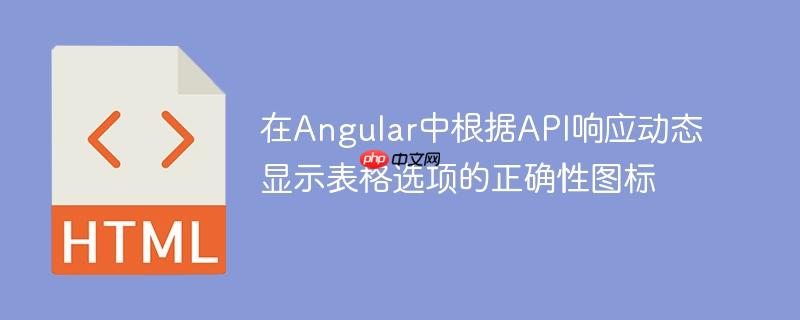
问题背景与挑战
在开发交互式web应用时,我们经常需要根据后端api的响应来动态更新前端ui。例如,在一个问答系统中,从api获取正确答案后,需要在表格中对应的选项旁显示一个“对勾”图标。最初的实现尝试可能涉及为每个图标设置一个独立的布尔变量(如showoption),并通过*ngif进行控制。然而,当问题和选项数量增多时,这种硬编码的方式会导致代码冗余、难以维护,且无法灵活适应动态变化的api数据。
一个典型的API响应可能如下所示,其中ansX表示第X个问题的正确选项的序号:
{
"ans1": "2",
"ans2": "1",
"ans3": "3"
}这意味着对于第一个问题,第二个选项是正确的;对于第二个问题,第一个选项是正确的,依此类推。如何在Angular的HTML表格中,基于这样的API响应,准确地在对应的选项前显示图标,是本教程要解决的核心问题。
核心策略:数据驱动与组件化
解决上述挑战的关键在于采用数据驱动的开发模式,并充分利用Angular的结构化指令(如*ngFor和*ngIf)。其核心思想是将问题和选项数据组织成一个清晰、可迭代的结构,然后通过循环渲染这些数据,并根据数据中的特定属性来条件性地显示图标。
优化数据模型
为了实现数据驱动的渲染,我们需要将后端返回的答案信息与前端的问题和选项数据进行整合,形成一个更易于模板渲染的数据模型。
推荐的数据模型结构:
我们建议定义以下TypeScript接口来规范数据结构:
// 定义选项接口
interface Option {
id: number; // 选项的唯一标识符,对应API返回的答案序号 (1, 2, 3, 4)
label: string; // 选项的显示标签,如 'a', 'b', 'c', 'd'
text: string; // 选项的具体文本内容
isAnswer: boolean; // 标记此选项是否为正确答案
}
// 定义问题接口
interface Question {
id: number; // 问题的唯一标识符,对应API返回的 ansX 中的 X
text: string; // 问题内容
options: Option[]; // 该问题的所有选项
}初始问题数据示例 (在组件中定义):
// app.component.ts
export class AppComponent implements OnInit {
questions: Question[] = [
{
id: 1,
text: "What type of investment is it?",
options: [
{ id: 1, label: 'a', text: "normal", isAnswer: false },
{ id: 2, label: 'b', text: "semi normal", isAnswer: false },
{ id: 3, label: 'c', text: "semi hard", isAnswer: false },
{ id: 4, label: 'd', text: "hard", isAnswer: false },
]
},
{
id: 2,
text: "How investment is it?",
options: [
{ id: 1, label: 'a', text: "normal", isAnswer: false },
{ id: 2, label: 'b', text: "semi normal", isAnswer: false },
{ id: 3, label: 'c', text: "semi hard", isAnswer: false },
{ id: 4, label: 'd', text: "hard", isAnswer: false },
]
},
{
id: 3,
text: "Why investment is it?",
options: [
{ id: 1, label: 'a', text: "normal", isAnswer: false },
{ id: 2, label: 'b', text: "semi normal", isAnswer: false },
{ id: 3, label: 'c', text: "semi hard", isAnswer: false },
{ id: 4, label: 'd', text: "hard", isAnswer: false },
]
}
];
// ... 其他代码
}实现步骤
步骤一:处理API响应并构建数据模型 (TypeScript)
在组件中,当从API获取到答案数据后,我们需要遍历questions数组,并根据API响应更新每个选项的isAnswer属性。
// app.component.ts
import { Component, OnInit } from '@angular/core';
// ... (Question 和 Option 接口定义)
@Component({
selector: 'app-root',
templateUrl: './app.component.html',
styleUrls: ['./app.component.css']
})
export class AppComponent implements OnInit {
questions: Question[] = [
{
id: 1,
text: "What type of investment is it?",
options: [
{ id: 1, label: 'a', text: "normal", isAnswer: false },
{ id: 2, label: 'b', text: "semi normal", isAnswer: false },
{ id: 3, label: 'c', text: "semi hard", isAnswer: false },
{ id: 4, label: 'd', text: "hard", isAnswer: false },
]
},
{
id: 2,
text: "How investment is it?",
options: [
{ id: 1, label: 'a', text: "normal", isAnswer: false },
{ id: 2, label: 'b', text: "semi normal", isAnswer: false },
{ id: 3, label: 'c', text: "semi hard", isAnswer: false },
{ id: 4, label: 'd', text: "hard", isAnswer: false },
]
},
{
id: 3,
text: "Why investment is it?",
options: [
{ id: 1, label: 'a', text: "normal", isAnswer: false },
{ id: 2, label: 'b', text: "semi normal", isAnswer: false },
{ id: 3, label: 'c', text: "semi hard", isAnswer: false },
{ id: 4, label: 'd', text: "hard", isAnswer: false },
]
}
];
ngOnInit() {
// 模拟API调用,获取答案数据
this.fetchAnswers().subscribe(apiResponse => {
this.processApiResponse(apiResponse);
});
}
// 模拟API服务调用
fetchAnswers(): Observable<{ [key: string]: string }> {
// 实际应用中,这里会是一个真正的HTTP请求
const mockApiResponse = { ans1: "2", ans2: "1", ans3: "3" };
return of(mockApiResponse).pipe(delay(500)); // 模拟网络延迟
}
// 处理API响应,更新questions数据
processApiResponse(apiResponse: { [key: string]: string }): void {
this.questions.forEach(question => {
const apiAnswerKey = `ans${question.id}`;
if (apiResponse.hasOwnProperty(apiAnswerKey)) {
// 将API返回的字符串答案序号转换为数字
const correctOptionIdFromApi = parseInt(apiResponse[apiAnswerKey], 10);
question.options.forEach(option => {
// 如果选项的ID与API返回的正确答案ID匹配,则设置为正确答案
option.isAnswer = (option.id === correctOptionIdFromApi);
});
}
});
}
}请注意,of和delay需要从rxjs和rxjs/operators导入:
import { Observable, of } from 'rxjs';
import { delay } from 'rxjs/operators';步骤二:在Angular模板中渲染数据 (HTML)
在HTML模板中,我们将使用*ngFor指令来遍历问题列表,并在每个问题内部再次使用*ngFor来遍历其选项。ion-icon的显示则通过*ngIf="option.isAnswer"来控制。
| 序号 | 内容 |
|---|---|
| {{ qIndex + 1 }} | {{ question.text }} |
| {{ option.label }} |
|
注意事项与最佳实践
- 数据转换逻辑的封装: 如果API响应格式复杂或需要进行大量转换,可以考虑将processApiResponse逻辑封装到一个单独的服务中,以保持组件的整洁。
- 错误处理: 在实际的API调用中,务必添加错误处理机制(例如,使用catchError操作符),以应对网络请求失败或API返回异常数据的情况。
- 性能优化: 对于大型数据集,确保*ngFor中的trackBy函数能够帮助Angular优化DOM更新,尤其是在列表项会频繁增删改时。
- 可访问性 (Accessibility): 对于图标,可以考虑添加aria-hidden="true"或提供屏幕阅读






























